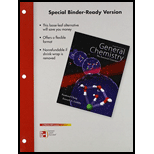
Concept explainers
Interpretation: By using percent composition by mass concept the identification of unknown compound has to be explained.
Concept introduction: Percent composition by mass of each element present in a compound is known as the compound’s percent composition by mass.
To explain: The identification of unknown compound by using percent composition by mass concept.
Explanation of Solution
Percent composition by mass: percent composition by mass of each element present in a compound is known as the compound’s percent composition by mass. The formula is expressed mathematically as follows
For example,
With the help of above details we can easily identify the unknown compound. The molecular formula of the unknown compound is calculated as follows:
The number of hydrogen atoms present in the unknown molecule is calculated as follows:
The number of hydrogen atoms present ion unknown compound is 2.
The number of oxygen atoms present in unknown the molecule is calculated as follows:
The number of oxygen atoms present ion unknown compound is 2.
The identification of unknown compound was explained by percent composition by mass concept.
Want to see more full solutions like this?
Chapter 3 Solutions
Loose Leaf For General Chemistry With Connect Access Card
 ChemistryChemistryISBN:9781305957404Author:Steven S. Zumdahl, Susan A. Zumdahl, Donald J. DeCostePublisher:Cengage Learning
ChemistryChemistryISBN:9781305957404Author:Steven S. Zumdahl, Susan A. Zumdahl, Donald J. DeCostePublisher:Cengage Learning ChemistryChemistryISBN:9781259911156Author:Raymond Chang Dr., Jason Overby ProfessorPublisher:McGraw-Hill Education
ChemistryChemistryISBN:9781259911156Author:Raymond Chang Dr., Jason Overby ProfessorPublisher:McGraw-Hill Education Principles of Instrumental AnalysisChemistryISBN:9781305577213Author:Douglas A. Skoog, F. James Holler, Stanley R. CrouchPublisher:Cengage Learning
Principles of Instrumental AnalysisChemistryISBN:9781305577213Author:Douglas A. Skoog, F. James Holler, Stanley R. CrouchPublisher:Cengage Learning Organic ChemistryChemistryISBN:9780078021558Author:Janice Gorzynski Smith Dr.Publisher:McGraw-Hill Education
Organic ChemistryChemistryISBN:9780078021558Author:Janice Gorzynski Smith Dr.Publisher:McGraw-Hill Education Chemistry: Principles and ReactionsChemistryISBN:9781305079373Author:William L. Masterton, Cecile N. HurleyPublisher:Cengage Learning
Chemistry: Principles and ReactionsChemistryISBN:9781305079373Author:William L. Masterton, Cecile N. HurleyPublisher:Cengage Learning Elementary Principles of Chemical Processes, Bind...ChemistryISBN:9781118431221Author:Richard M. Felder, Ronald W. Rousseau, Lisa G. BullardPublisher:WILEY
Elementary Principles of Chemical Processes, Bind...ChemistryISBN:9781118431221Author:Richard M. Felder, Ronald W. Rousseau, Lisa G. BullardPublisher:WILEY





